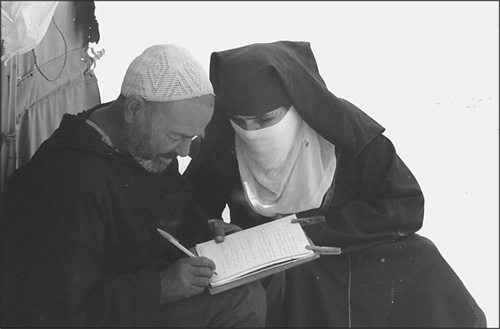
In cross-cultural encounters it is easy to jump to an erroneous conclusion about another person’s motives, behavior, and character when we base our judgments on assumptions from our own culture. One way to arrest our rush to judgment is to separate out three aspects of perceiving another’s behavior. D.I.E. is an easy-to-remember initialism that might come in handy, but actually gaining the skills involved requires some practice.
D: Description. The task is to describe only what you see, an objective listing of facts, without drawing any conclusions.
I: Interpretation. Now you can interpret what you think about what you see. What is your guess about what is going on in the situation?
E: Evaluation. Now you can express your feelings about what you think is going on.
Let’s practice with this picture:

© 1982, Joel Gordon
First, let’s make a list of what we can observe from the photograph:
1. A man is holding a pen and a pad of paper.
2. He is wearing a hat.
3. A figure that could be a woman is sitting close to the man.
Add a few more observable facts, but be careful not to interpret yet.
Now, let’s list a few possibilities of what we think could be going on in the photo.
1. It could be that they are married. They have found a husband for their daughter, and the man is signing the marriage contract.
2. It could be that he is Deaf and he is writing a note to communicate with his hearing sister.
3. It could be the woman is teaching the man how to write.
Write down a couple of alternate interpretations.
Finally, you may put down your emotional reaction (either positive or negative) to the interpretations, matching the numbers for I and E.
For example, Interpretation 1 was “It could be that they are married. They have found a husband for their daughter, and the man is signing the marriage contract.” First, come up with a positive reaction to that statement, such as
1. (positive reaction) I am glad they are setting up their daughter for a good future.
Then write a negative reaction to Interpretation 1, for example,
(negative reaction) I think it’s terrible that the daughter has no freedom to choose her own husband.
For Interpretation 2 we had “It could be that he is Deaf and he is writing a note to his hearing sister.”
2. (positive reaction) I feel happy that the hearing sister is taking the time to write to him.
(negative reaction) I am angry that she never took the time to learn sign language.
Now you try writing one positive and one negative reaction to Interpretation 3 (“It could be that the woman is teaching the man how to write.”)
Of course, the reactions listed in 1 and 2 (above) are only examples of possible evaluations and not necessarily how you would feel about these possible interpretations. Now take your Interpretations 4, 5, and 6 (on page 22) and write corresponding reactions, either positive or negative.
Now try to do all three steps on your own, in pairs or in small groups, for the next picture:

American Museum of Natural History Library
Describe what you see.
What do you think is going on?
What are your feelings about what you think is going on?
For a description of what these photographs actually depict, see page 115.
Of course, the point of the D.I.E. exercise is to skillfully analyze face-to-face encounters, not photographs. Can you recall an interaction you have had with someone from another culture (including Deaf/hearing or other subcultures) when you may have come to a conclusion about the other person’s behavior based on a quick judgment? Try to go back mentally and separate out the three components: Description, Interpretation, and Evaluation.
Here is an example of something that happened to me recently. I was to interpret a wedding ceremony for a Deaf friend of the groom’s. I approached this assignment with some trepidation because it was to take place in a church I had never visited. I had no previous experience with this religious denomination but assumed it to be quite strict and devout.
Upon entering the church, I realized that the event was further complicated by the fact that most of the guests were speaking a language other than English. It turned out that the bride’s family and friends were members of a cultural and linguistic community. Luckily, the minister was bilingual and conducted the service by alternating between English and the other language. Unfortunately, he failed to translate all the prayers and symbolic rituals into English. I was consequently left guessing about the significance of many parts of the ceremony. The most striking feature of this church for me was the total lack of music. I concluded that perhaps this religious denomination was so strict that it prohibited music. Inwardly, I pitied the wedding couple and the congregation.
Later, after the service, as I stood in line for the restroom, I happened to overhear one wedding guest whispering to another (in English, fortunately) about what a shame it was that the organist had taken sick at the last minute. I muffled a gasp as I realized how I had nearly left the church having made a completely erroneous judgment.
Analysis of one element of my story:
Description: There was no music in the wedding ceremony.
Interpretation: I concluded that this religious denomination was so strict that it prohibited music in its services.
Evaluation: I felt sorry for the wedding party.
Looking back I see how dangerous it is to come to a conclusion about another culture based on too little information.
Now you try to analyze an incident, either by writing about it on your own or in discussion with members of a small group, taking turns telling your stories.
Objectively describe what happened.
Include your interpretation at the time this interaction occurred, plus some alternate possibilities that you can see in hindsight.
Describe how you felt at the time, given your interpretation, plus other feelings that might result from your alternative interpretations.
Looking back on this experience, do you have a different perspective than you did before?
Adapted from an exercise often attributed to Milton and Janet Bennett.